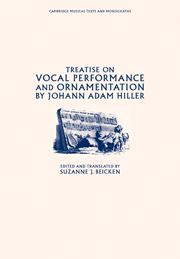Book contents
- Frontmatter
- Contents
- Acknowledgments
- Translator's introduction and commentary
- Note on the text and musical examples
- TREATISE ON VOCAL PERFORMANCE AND ORNAMENTATION
- Preface
- Dedication
- 1 On the qualities of the human voice and its improvement
- 2 On good performance and how to use the voice
- 3 On good performance, with regard to text and music
- 4 On good performance, with regard to ornaments
- 5 On good performance, with regard to passaggi
- 6 On good performance, with regard to the various genres of vocal forms and in consideration of performing in various places
- 7 On cadenzas
- 8 On arbitrary variation of the aria
- Appendix
- Bibliography
- Index
5 - On good performance, with regard to passaggi
Published online by Cambridge University Press: 22 September 2009
- Frontmatter
- Contents
- Acknowledgments
- Translator's introduction and commentary
- Note on the text and musical examples
- TREATISE ON VOCAL PERFORMANCE AND ORNAMENTATION
- Preface
- Dedication
- 1 On the qualities of the human voice and its improvement
- 2 On good performance and how to use the voice
- 3 On good performance, with regard to text and music
- 4 On good performance, with regard to ornaments
- 5 On good performance, with regard to passaggi
- 6 On good performance, with regard to the various genres of vocal forms and in consideration of performing in various places
- 7 On cadenzas
- 8 On arbitrary variation of the aria
- Appendix
- Bibliography
- Index
Summary
The German term Passagie comes from the Italian passaggio, which means passage. In application to music it signifies nothing more than two or three notes which are included in the transition under the control, as it were, of one harmonic tone. It can also be translated by the word Übergang (transition). Altogether this might have been the way in which passaggi originated (as the term itself suggests): by filling in the notes that form a leap in a stepwise fashion, instead of performing a mere jump. Thus, two or three notes which replace a single one already constitute a passaggio, although one generally applies this term to continuous figures which often consist of chains of many measures, with two-, three- and four-note figures. The word figure, then, is the most convenient term by which to label the individual part of such a passaggio. Some music teachers employ the Greek word melisma to designate both a single figure and passaggio, although the latter is sometimes referred to as a melismatic extension, as well.
While many singers, both male and female, have caused a sensation (and still continue to do so) with their use of passaggi, they have been met both with great admiration and with disdain. This, however, is not the place to put this matter on trial and pass a verdict.
- Type
- Chapter
- Information
- Publisher: Cambridge University PressPrint publication year: 2001



